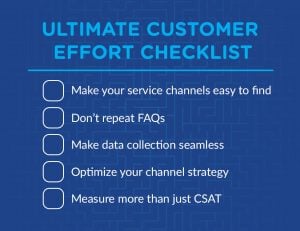
Customer effort — the amount of time or effort a customer has to put in to get an issue resolved — can be complicated. There are a lot of different obstacles that can drive up customer effort, and measuring it isn’t always very straightforward, either.
But the benefits of reducing customer effort can be substantial. So how can you get started with making sure you are providing a customer experience that isn’t fraught with obstacles?
Start by following our simple checklist:

Make your service channels easy to find
Did you know that nearly half of your customers are already frustrated by the time they reach out to you? So don’t make the customer service process any more difficult than it has to be — make your service channels easy to find and easy to reach. Consider placing all of your information in one place, somewhere that is easily accessible from the home page.
Don’t repeat FAQs
Customers don’t just reach out to you anymore — they do their research. This means looking up answers on forums, Google, etc. So when your customer reaches your automated system, only to have the FAQs they’ve already read through repeated to them, they view it as a waste of time. And that drives up customer effort (and frustration). Automated systems should be used to increase efficiency, not serve as gatekeepers — or worse — roadblocks.
Make data collection seamless
The benefit of automated systems that are well-designed is that they can collect information upfront to save time for your customers and your agents. Too often, though, the data that is collected through the automated system doesn’t get passed to the agent — and your customers have to repeat themselves. Instead, focus on optimizing your automated system so that your live agents get the data they need while your customers enjoy a seamless and quick experience.
Optimize your channel strategy
It’s no secret that your customers are present on multiple channels — and that they expect you to be able to meet their needs whether they’re at home or on the go. But the pressure to deploy an omnichannel strategy often leads many companies to implement less frequently used channels, such as social media or text, poorly. Figure out which channels your customers use most often and focus on deploying those effectively.
Measure more than just CSAT
CSAT is important — but it’s not the only metric you need to measure. Now that you know the impact of customer effort on your customer’s frustration levels, make sure to develop a way to consistently and effectively measure the amount of effort your customers are putting in, and reduce unnecessary obstacles whenever possible.



